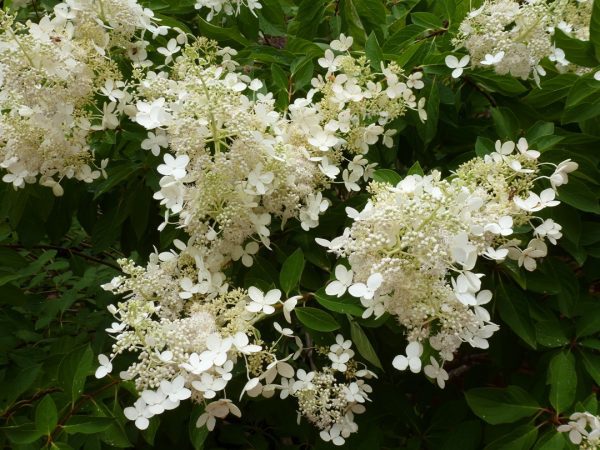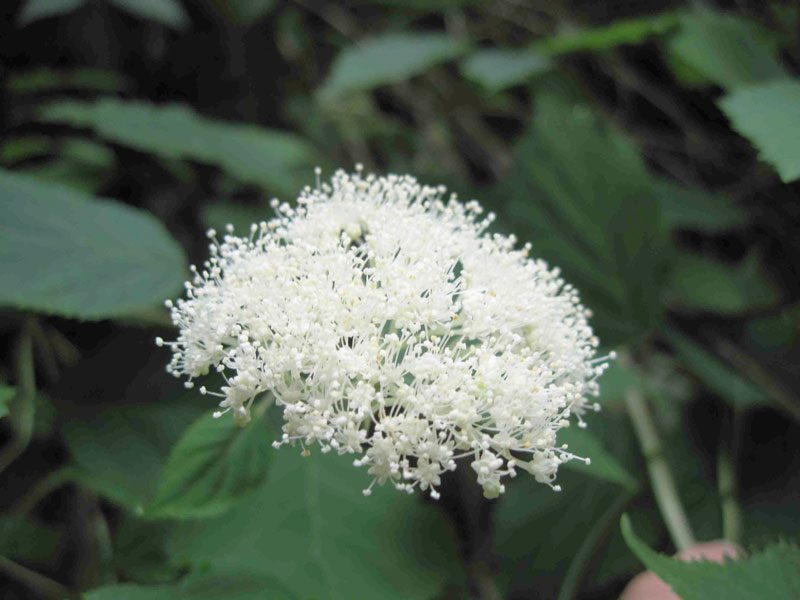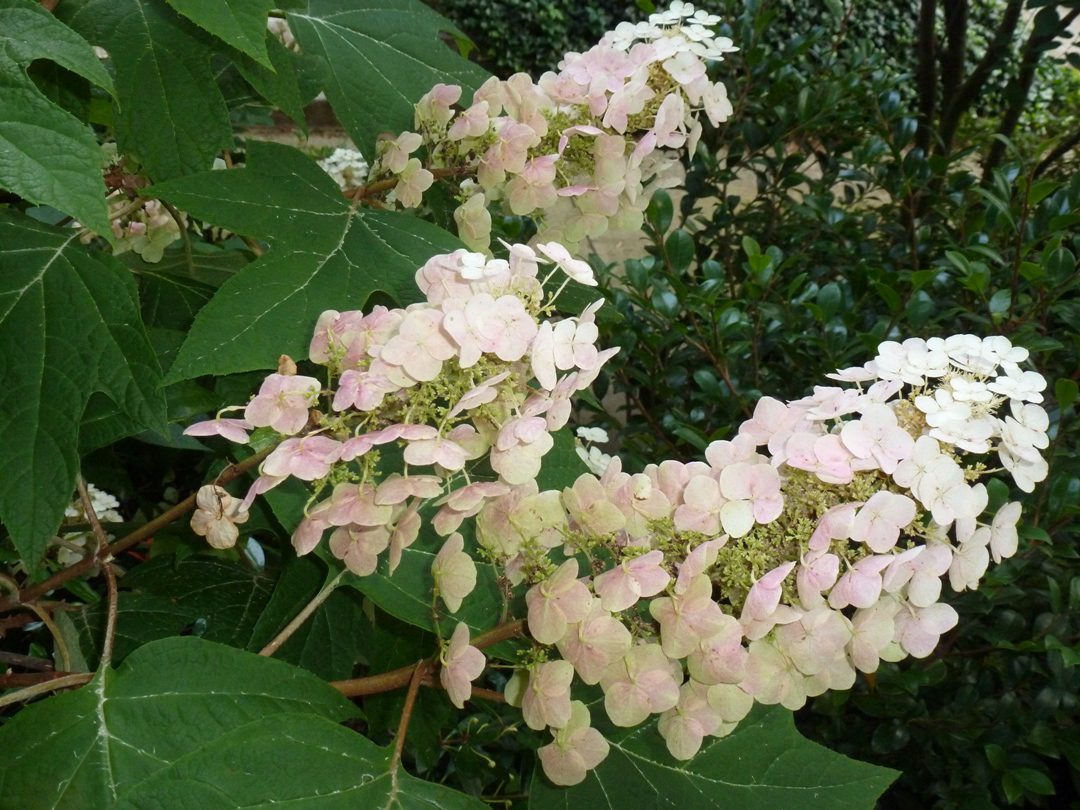Hydrangeas, summer’s coolest flower

On the cusp of summer, just when I begin to dread the onset of unrelenting heat and humidity, a cool and soothing vision appears in our forests and yards – the blooms of native and Asian hydrangeas.
Wild hydrangea (Hydrangea arborescens) is uncommon, even rare, in the Piedmont. I’ve seen them at only one location in the Uwharries, clinging to the edge of a rocky drain on a northwest slope. In a shady woodland setting, the flat, white clusters seem to float at the tips of weak, sprawling branches. The blooms are composed primarily of tiny, fertile flowers.
I’ve seen them at only one location in the Uwharries, clinging to the edge of a rocky drain on a northwest slope. In a shady woodland setting, the flat, white clusters seem to float at the tips of weak, sprawling branches. The blooms are composed primarily of tiny, fertile flowers.
Showy flowers – like those we’re used to seeing on the typical mophead hydrangeas in our gardens – are sterile. A plant in the wild doesn’t have much incentive to produce sterile flowers, but specimens that exhibit this trait have been selected and cultivated for the nursery trade. “Annabelle” has heavy globes of showy flowers that go from green to white then back to green over the course of several months.
Oakleaf hydrangea (H. quercifolia) is native to the Deep South, but it’s a trooper in our Piedmont gardens. These large, robust shrubs are more drought tolerant than other hydrangeas. The leaves hold up well all season and offer outstanding fall color.  Some varieties shed the last of their leaves only as the new ones emerge in spring. The peeling bark is also a handsome feature in the winter garden. Have I mentioned the blooms? They’re magnificent – large, cone-shaped panicles usually held upright. Starting off white, some varieties fade to rose and burgundy then turn a semi-translucent tan, resembling parchment paper. The variety known as “Snowflake” has its own particular charm. The panicles begin to droop as new flowers (actually bracts) emerge over several weeks. The older flowers fade to green and tan, but the new ones are fresh and white as falling snow. What a sight for sore eyes in mid-July!
Some varieties shed the last of their leaves only as the new ones emerge in spring. The peeling bark is also a handsome feature in the winter garden. Have I mentioned the blooms? They’re magnificent – large, cone-shaped panicles usually held upright. Starting off white, some varieties fade to rose and burgundy then turn a semi-translucent tan, resembling parchment paper. The variety known as “Snowflake” has its own particular charm. The panicles begin to droop as new flowers (actually bracts) emerge over several weeks. The older flowers fade to green and tan, but the new ones are fresh and white as falling snow. What a sight for sore eyes in mid-July!
Old-fashioned bigleaf hydrangeas (H. macrophylla) have long been a staple in Piedmont gardens. The blooms of this Asian species tend to be blue in our region due to the acid soil created by leaf litter and pine needles, but they’ll turn pink with copious additions of lime. Instead of going to all that trouble, it’s easy to find a variety with the color that suits you. This species has given rise to a staggering number of cultivars in shades of white, pink, red, purple and blue. They also come in two forms – mophead and lacecap. A similar species, mountain hydrangea (H. serrata), is a smaller and more compact lacecap, also available in a range of colors. These are thought to be more cold-tolerant, but that feature generally isn’t an issue in the Piedmont.
In late summer and early fall, just when hydrangeas seem finished for the season, the panicle hydrangeas (H. paniculata) kick in. Another import from Asia, these 10- to 20-foot shrubs can be limbed up and grown as small trees. Numerous cultivars are available, with blooms taking the form of rounded globes or pointy spires. “Chantilly Lace” would be a fine backdrop for an outdoor wedding. The green and white blooms of “Limelight” turn a deep, rich pink in fall, making for a vibrant color combination.
No yard is too small for a hydrangea. I put a climbing hydrangea (H. anomala) in a container on our terrace with golden variegated sweet flag at its feet and let it scramble up a trellis. At the Atlanta Botanical Garden, they circle the trunks of massive trees and camouflage unattractive brick walls. (The garden has one of the finest collections of hydrangeas in the Southeast, with more than 160 cultivars of bigleaf hydrangea and unusual varieties of many other species.)
Hydrangeas also have a place inside. Fresh-cut or dried, the flowers make long-lasting additions to floral arrangements. This leads to perhaps the most vexing question about hydrangeas: When do you prune them? Confusion abounds. According to Dick Bir, a retired extension specialist at the Mountain Research and Extension Center in Fletcher, H. arborescens and H. paniculata (wild hydrangea and panicle, respectively) bloom on new growth while H. macrophylla (bigleaf) and H. quercifolia (oakleaf) bloom on old growth. Knowing the species will allow you to prune with confidence.
In general, hydrangeas shouldn’t need a lot of pruning. As with any shrub, they should be planted in an area where they can reach full size. Also bear in mind that hydrangeas ought to have a loose structure, not a tight, rounded form. Every few years, remove some of the older, less productive canes by cutting them back to the ground. A light tip pruning to remove spent blooms shouldn’t cause a problem, regardless of when it’s done. Really, on a hot summer day, you want to be able to look at your hydrangeas and feel calm cool and collected, not burdened by the thought of sweaty work.
For hydrangea fans, a slideshow
[view:slideshow2=block_1]